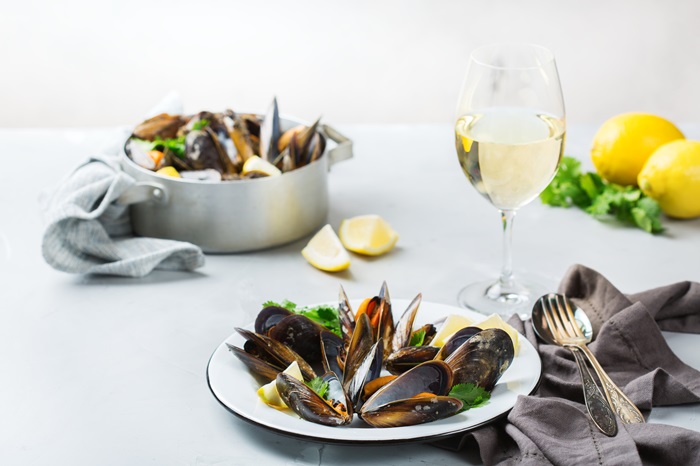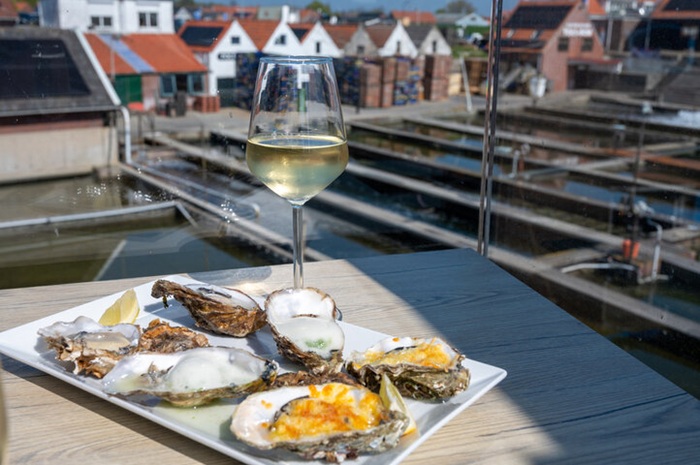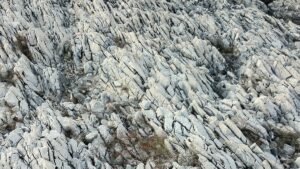
Chablis, a magical name that instantly calls to mind the world of dry – and particularly fresh – white wines and their natural affinity with the treasures of the sea. Generally speaking, Chablis wines are true mealtime companions. Their freshness, tension and clean, understated aromas make them remarkably easy to pair with food. Let the iDealwine team of seasoned food lovers guide you through the essentials for this iconic Burgundy wine.
Food and wine pairings: General guidelines
It almost goes without saying, the subtle salty, iodine-like notes that so often define Chablis, on the nose and on the palate, make it a perfect match for seafood. Think of freshly opened oysters or a fine piece of fish. Here, it’s essential to avoid wines aged in oak, the pronounced woody aromas pair very poorly with the clean, briny delicacy of oysters and raw shellfish in general.
Broadly speaking, there’s little difference between the kinds of dishes that suit a classic Chablis and those that flatter a Grand Cru. The main food categories naturally remain the same. The key lies in balancing the complexity of flavours and textures in your dish with the depth and structure of the wine. So then, what should you eat alongside a glass of Chablis? We walk you through the distinctive character of each Chablis appellation, along with tips on cellaring, alongside wine and food pairings that’ll help you make the most of every bottle. Let’s dive in!
Chablis pairings by appellation
Petit Chablis
- Tasting notes: In the glass, Petit Chablis reveals itself with a delicate, pale yellow hue tinged with subtle green glints. Its bouquet is essentially youthful and primary, meaning it shows no signs of ageing. Expect fragrant notes of crisp white fruits, like Granny Smith apples and pears, alongside white blossoms such as hawthorn and acacia. There is also a bright citrus lift, with hints of lime, and an underlying mineral thread of flint and chalk. On the palate, the wine is lively and vibrant, driven by a high natural acidity typical from Chardonnay grown in this terroir. The saline finish is sometimes rounded off by a subtle richness.
- Serving suggestions: Perfect as an aperitif since it truly sharpens the senses, Petit Chablis also works beautifully when pairing with food. It partners naturally with seafood dishes, delicately flavoured dishes that won’t overpower its aromas, or creamy cheeses whose richness is cut by the wine’s zesty drive. Serve well chilled, ideally between 9°C and 10°C.
- Ageing potential: While Petit Chablis is charming in its youth, we recommend a couple of years in the cellar to allow it to develop a touch more complexity and poise.
- Petit Chablis worth discovering: Clotilde Davenne, Louis Moreau, L’Enclos
Chablis
- Tasting notes: A step up from Petit Chablis, Chablis reveals a pale yellow hue threaded with delicate green glints. The bouquet shows greater complexity, as subtle secondary aromas emerge. Alongside notes of white fruits and stone fruits, think white peach, you’ll detect hints of liquorice, hay, and aromatic herbs, interwoven with touches of mushroom and undergrowth. Gentle hints of sweet spice take shape with age. On the palate, fine and precisely etched, it delivers remarkable purity right through to the finish.
- Serving suggestions: Serve well chilled, Chablis earns its place at the heart of the table. It pairs beautifully with dishes that carry a subtle iodine note, such as delicate fish or fresh seafood. And for something different, try it with marinated chicken in preserved lemon, a truly delightful combination.
- Ageing potential: Chablis can be enjoyed in its youth. You can open it anywhere between five and eight years after the vintage year.
- Chablis worth discovering: William Fèvre, Jean Dauvissat

Chablis Premier Cru
- Tasting notes: Unlike Petit Chablis and Chablis, this appellation is strictly defined and subdivided into forty distinct climats. Among these, seventeen hold particular prominence and are seen as the true flag bearers of the Premier Cru category. Each has its own distinct profile, offering a wide spectrum of expressions within this classification. Generally speaking, these wines display a deeper yellow hue than Petit Chablis and Chablis. Depending on vineyard exposure and fruit ripeness, the texture can show more flesh and generosity, yet always retains its drive: vibrant, energetic, and mineral, with a crystalline edge that sets it apart from its counterparts.
- Serving suggestions: Serve at around 12°C. Chablis Premier Cru shines alongside a green vegetable risotto or a regional cheese board.
- Ageing potential: With careful cellaring, Chablis Premier Cru can comfortably reach ten years of age. Its hallmark minerality remains beautifully preserved.
- Chablis Premier Cru worth discovering: Albert Bichot, Billaud-Simon
Chablis Grand Cru
- Tasting notes: As always, minerality takes centre stage, beautifully complemented by floral nuances and refined notes of fresh almond, honey, and juicy, white-fleshed fruits. On the palate, the texture is sumptuous and finely woven, underpinned by a noble, flavoursome richness that lingers with exceptional finesse.
- Serving suggestions: These are majestic gastronomic wines, best enjoyed at full maturity. Their subtle – even perfect – balance of salinity, richness, tension, and gently evolved spice notes make them sublime companions for creamy poultry dishes, sautéed mushrooms, or a white truffle risotto.
- Ageing potential: Chablis Grand Cru demands patience to reveal its full breadth and generosity. Ten to fifteen years of cellar ageing will reward you with remarkable depth and harmony.
- Chablis Grand Cru worth discovering: Jean-Paul et Benoît Droin, Raveneau, Vincent Dauvissat
All our Chablis wines for sale on iDealwine



